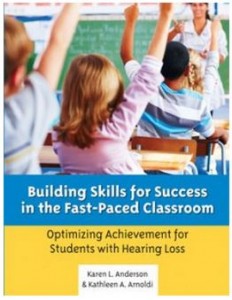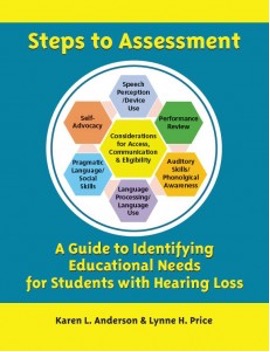Related Products
For Professionals
- Amplification
- Assessment of Student Skills, Challenges, Needs
- Early Childhood: Infants, Toddlers, Preschool
- Hearing Loss – Identification, Impact and Next Steps
- IDEA Law Summary Information
- Language and Speech Development Issues
- Legal Issues in Serving Children with Hearing Loss
- Listening (Auditory Skills) Development
- Planning to Meet Student Needs
- Self-Advocacy Skills for Students with Hearing Loss
- Self-Concept: How the Child with Hearing Loss Sees Himself
- Social Skills
- Speech Perception & Learning
Related Teacher Tools Takeout Items
The Road from Referral to Eligibility isn’t Easy

The terms: child find, referral, evaluation and re-evaluation can cause an involuntary reaction of panic in teachers. Just the THOUGHT of ASSESSING a child for a disability instills immediate concern that you just might not know what you’re doing after all. Eligibility can only be identified through the use of ASSESSMENTS, so the road to eligibility begins there! This article will help you with the WH questions of assessment and eligibility and ease the anxiety.
Eligibility Essentials
| If the creators of IDEA wanted to make it clear that good grades = no IEP they would have clearly done so – but they did not. |
WHO should be evaluated? Any children who are suspected of being a child with a disability and in need of special education, even though they are advancing from grade to grade, or any student who has been referred to the district due to concerns that a student may be a child with a disability (IDEA Sec. 300.111). Parents must consent to an educational evaluation.
WHO can make a referral for evaluation? A parent/guardian, classroom teacher, and any member of the school district (public or private) can make a referral to request an evaluation. Also, a child can be court ordered for testing by a court judicial system.
WHAT are the first steps in the eligibility process? The referral starts with an initial request for Evaluation. The district is responsible for sending home a notice to evaluate, to inform parents/guardians of procedural safeguards, and get written permission to evaluate the student. This notice is to be mailed home within 10 days of the initial request. Once a school district receives the request, they can request screening of skills to indicate if an evaluation is warranted or approve the request and initiate a full evaluation. Once this is decided, there is a 60-day deadline to complete the evaluation and determine eligibility.
|
Looking for a list of appropriate tests? Download our free handout: Resources for Identifying DHH Student Needs: Eligibility Assessment and Beyond. |
WHAT exactly should BE assessed? IDEA Section 300.304 stipulates that assessments and other evaluation materials include those TAILORED to assess specific areas of educational need. Assessments MUST be “technically sound instruments that may assess the relative contribution of cognitive and behavioral factors, in addition to physical or developmental factors.” You MUST use a “variety of assessment tools and strategies to gather relevant functional, developmental, and academic information, including information provided by the parent.” Therefore, you MUST “not use any ONE single measure or assessment as a sole criterion for determining whether a child is a child with a disability.” A variety of assessments means to use various types of tests to get a thorough picture of the child’s needs. EVERY student with hearing loss who is going through initial assessment needs to have cognitive testing in order to accurately and appropriately estimate if/how much the hearing loss has impacted development based on the student’s ability compared to peers with typical hearing. Students with hearing loss (DHH-only) often experience delays secondary to access issues. There will be many school teams who resist the need to perform cognitive testing because there isn’t a question about cognitive delay. Title II of the Americans with Disabilities Act requires that schools ensure that communication for students who are deaf and hard of hearing is as effective as communication for others through the provision of appropriate aids and services, thus affording an equal opportunity to obtain the same result, to gain the same benefit, or to reach the same level of achievement as that provided to others. (“Frequently Asked Questions on Effective Communication for Students with Hearing, Vision, or Speech Disabilities in Public Elementary and Secondary Schools”)
The relevance of cognitive testing to point out is that it is important to determine the student’s cognitive level to determine the expectations for reaching the same level of achievement as that provided to others. A student with above average cognitive ability should have the access, and therefore the opportunity, to reach the same level of achievement as other students with above average intelligence.
BE INVOLVED IN TEST ADMINISTRATION Knowledgeable, trained professionals in the area of expertise being assessed is important for test validity. TODHH often test for functional levels of achievement and performance. While academic assessments are important for learning the full spectrum of needs, functional performance and achievement is just as important in gaining an understanding of needs and determining level of service delivery. Eligibility is determined by assessing overall “health, vision, hearing, social, emotional, academic, communicative and motor abilities.” (IDEA: §300.301) The main goal of Eligibility Assessment is to gain a comprehensive view of the students’ current deficits and determine if they will need specially designed instruction to make meaningful gains in academic and functional performance of skills, despite their disability.
TESTING CONDITIONS Preferably in a location with optimal sound acoustics, reduced background noise and over multiple sessions if testing is lengthy. Since educational needs of students with hearing loss are related to access, we need to be truthful regarding students’ typical communication access when we administer tests, in order to receive truthful representations of their typical abilities. When TODHH are testing students who are DHH it is important to consider the students’ ‘usual communication situation.’ If the student usually uses classroom hearing assistance technology (HAT), then it should be used during testing. If the student has hearing aids, but rarely uses them, then the ‘usual condition’ would be to test without the hearing aids. Since being able to see the speaker’s face is very hit or miss in any situation, it is reasonable to disallow speechreading during the testing for students who are hard of hearing. If a student uses sign language, test through the classroom interpreter as the ‘usual condition’. Even when choosing to not allow speechreading, the results will still be better than what occurs in a classroom because of the limited background noise in the test situation (unless HAT is used). Some tests, like the Oral Passage Understanding Scale (OPUS) and the Listening Comprehension Test can be given to visual communicators using ASL, although a note about not administering the test protocol as recommended must be included when reporting results.
WHAT ASSESSMENTS SHOULD BE USED? Itinerant teachers don’t typically teach core content classes like Reading, Literacy, Math, Science or Social Studies. TODHH can ask the general education teachers to provide testing information on academics, and then supplement their information with specific literacy diagnostic tests, to test specific areas of reading difficulties such as vocabulary assessments or phonological awareness. TODHH can assess written language, oral language, and communication skills.
Most of the time, itinerant teachers are giving informal functional skill assessments using rubrics and checklists. TODHH test for Auditory Skill Development, Communication Skills, Self-Advocacy Skills, Pragmatic Language, Social Skills, Access to Instruction, ASL/English Development, Secondary Transition skills and Educational Risk and Fatigue. Performance of the expanded core skills needed for full participation (self-advocacy, communication repair, knowledge about hearing loss, amplification independence, etc.) are necessary for a student to be fully prepared to function as an adult. These are NOT standard areas of evaluation for other students with special needs, but they must be considered as part of a tailored assessment for students who are deaf or hard of hearing.
Products and articles about assessments for students with HL can all be found HERE. Informal inventories such as the SIFTERS, CHAPS, LIFE-R, CHILD and more, can be found in the Building Skills for Success in the Face Paced Classroom or individually in the Teacher Tools Takeout under the Assessment category.

The terms: child find, referral, evaluation and re-evaluation can cause an involuntary reaction of panic in teachers. Just the THOUGHT of ASSESSING a child for a disability instills immediate concern that you just might not know what you’re doing after all. Eligibility can only be identified through the use of ASSESSMENTS, so the road to eligibility begins there! This article will help you with the WH questions of assessment and eligibility and ease the anxiety.
References:
“Sec. 300.111 (D).” Individuals with Disabilities Education Act, sites.ed.gov/idea/regs/b/b/300.111/d. Accessed 6 Sept. 2022.
U.S. Department of Education. “Sec. 300.8 Child with a Disability.” Individuals with Disabilities Education Act, 25 May 2018, sites.ed.gov/idea/regs/b/a/300.8.
“Sec. 300.304 (B).” Individuals with Disabilities Education Act, sites.ed.gov/idea/regs/b/d/300.304/b.
Addressing the Need for Appropriate Use of Norm-Referenced Test Instruments. Supporting Success, December 2017.
Author: Michelle Andros

